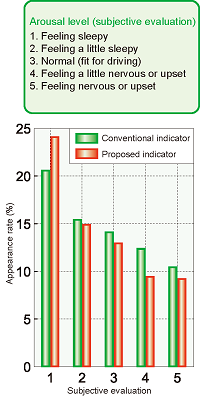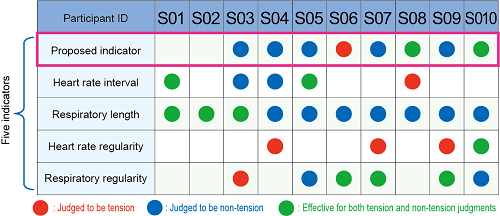29. Detection of changes in drivers' physical and mental state using physiological indicators
In order to maintain safe train operations, it is important that the driver, who works alone, is always in good physical and mental condition. Therefore, we have proposed a method for detecting the states that may affect safe operation, such as over-tension like panic and arousal reduction, from physiological data. Realizing this detection method makes it possible to provide appropriate support for the driver to return to good condition.
It has been considered difficult to apply physiological data for safety support which requires a high degree of accuracy, due to the large differences among individuals. Therefore, we have proposed physiological indicators using Heart rate and respiration to estimate the activity of the parasympathetic nervous system of autonomic nerve, which is activated during relaxation and suppressed during tension. Conventional indicators require 15 to 30 seconds for measurement, but the proposed indicators can be calculated in every respiratory cycle (about 3 seconds). The non-tension indicators appear more frequently than conventional indicators in arousal level 1, and they appear less in arousal levels 4 and 5, indicating higher estimation accuracy (Fig. 1). Measurement of respiration also has the advantage of providing information that reflects mental and physical state, such as startle reaction and sighing.
In addition, we have devised a method to automatically select effective indicators suitable for each individual from five indicators including the proposed indicators (Table 1), and determine both tension (including psychological agitation) and non-tension (including arousal reduction) with high accuracy using the selected effective indicators (comprehensive judgment method). As shown in Fig. 2, there are problems with the rate of appearance of correct judgments and the number of false positives in the judgments of individual indicators (in the purple box), but the judgments using the comprehensive judgment method (in the pink box) have both a high rate of appearance and a low rate of false positives for both tension and non-tension, indicating that judgments can be made with a high degree of accuracy.
Other Contents
- 22. Numerical simulation of ventilation in a vehicle by opening windows while running
- 23. Analytical evaluation method for the speed at which hunting occurs
- 24. Evaluation of the influence of wheel machining marks on the friction coefficient by visualizing the contact area
- 25. Wheel slide protection simulator to supplement on-track testing
- 26. Non-contact method to detect rail openings using aerial ultrasonic waves
- 27. Clarification of wear mechanism of current collecting materials caused by frictional heat
- 28. Method to evaluate physical properties of frictional materials by numerical simulation
- 29. Detection of changes in drivers' physical and mental state using physiological indicators
- 22. Numerical simulation of ventilation in a vehicle by opening windows while running
- 23. Analytical evaluation method for the speed at which hunting occurs
- 24. Evaluation of the influence of wheel machining marks on the friction coefficient by visualizing the contact area
- 25. Wheel slide protection simulator to supplement on-track testing
- 26. Non-contact method to detect rail openings using aerial ultrasonic waves
- 27. Clarification of wear mechanism of current collecting materials caused by frictional heat
- 28. Method to evaluate physical properties of frictional materials by numerical simulation
- 29. Detection of changes in drivers' physical and mental state using physiological indicators



